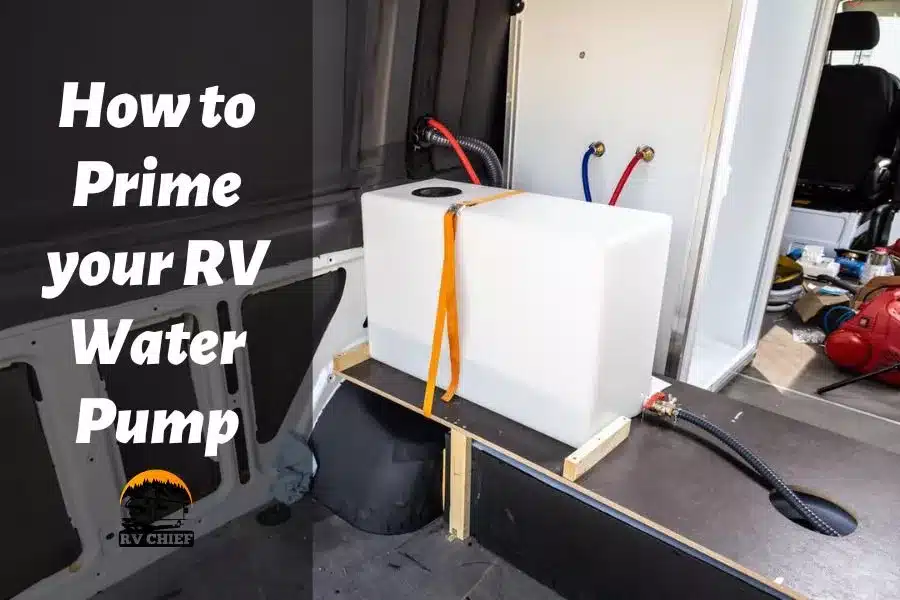As an RV owner, one of the essential components you rely on is your water pump. The water pump ensures a steady supply of fresh water for your RV’s plumbing system. However, if you encounter low water pressure or no water flow at all, it might be a sign that your water pump needs priming.
Priming the RV water pump involves flushing water back into the pump and forcing it through the machine to generate adequate pressure to enable the water to run smoothly and efficiently.
In this step-by-step guide, I will walk you through the process of priming your RV water pump against common mishaps, including leaks caused by cracks, defective valves, or a loose connection.
Let’s get started!
Table of Contents
- 1 Where is an RV water pump located?
- 2 How to Prime RV Water Pump In Nine Simple Steps
- 2.1 Step 1: Gather the necessary tools and materials
- 2.2 Step 2: Locate your water pump and Turn off the water pump and water heater
- 2.3 Step 3: Open the faucet
- 2.4 Step 4: Locate the water pump’s inlet and outlet valves
- 2.5 Step 5: Connect the water hose
- 2.6 Step 6: Submerge the other end of the hose
- 2.7 Step 7: Begin priming your RV water pump
- 2.8 Step 8: Close the faucet and check for leaks
- 2.9 Step 9: Test the water flow
- 3 Importance of priming Your RV water pump
- 4 RV water pump replacement tips
- 5 Warnings!
- 6 Conclusion
Where is an RV water pump located?

Before you start to prime your RV water pump, you first need to know where the pump is located. An RV water pump is often installed inside cabinets or underneath the car seats.
These are the most common places where an RV water pump can be stored. If you can’t locate it, you should read the manual.
Alternatively, simply trace the path from your cabinet located below the kitchen sink.
Once you locate the water pump, priming will be straightforward. If you don’t know the best way to proceed after identifying the water pump, perform an RV water pump troubleshooting.
*Note: You may consult a professional when you’re stuck.
Remember that when you don’t prime your RV water pump correctly, you might have to deal with other issues that will cost you in the long run.
How to Prime RV Water Pump In Nine Simple Steps
It doesn’t matter if you’re a seasoned RVer or a beginner. Knowing how to prime your water pump is an important skill that will save you time and money. Without proper priming, the pump won’t be able to draw water from the tank and distribute it throughout the system.
Now, here’s how you can easily prime your RV water pump in 9 simple steps.
Step 1: Gather the necessary tools and materials
Before priming your RV water pump, there are a few basic tools you are going to need for this process to make it smooth and efficient. So make sure you have the following items:
- Water
- A bucket or container that can hold over 12 ounces of water
- Rubber hose, and
- A screwdriver
- Adjustable wrench or pliers
- Teflon tape (if needed)
- RV owner’s manual (optional)
Step 2: Locate your water pump and Turn off the water pump and water heater
The first step is to locate the water pump in your RV. In most cases, the pump is installed near the water tank or inside a cabinet. Consult your RV owner’s manual if you’re unsure about its exact location.
Check whether all the faucets on the water pump are disconnected. If they are still connected, use a screwdriver to adjust the pump collar.
This should disconnect your water pump accordingly from its outlet. To do this, simply turn the screwdriver in a clockwise motion until it loosens up.
This ensures your safety and prevents any damage to the system during the priming process.
Step 3: Open the faucet
Next, open one of the faucets in your RV. This step helps release the pressure within the plumbing system and allows air to escape. Ensure that all faucets, including both hot and cold taps, are fully open.
When it loosens up, pull the water hose away from the water pump. After that, water will flow directly through the hose and into your RV, and it will be distributed to your showerheads, toilet, and kitchen.
Step 4: Locate the water pump’s inlet and outlet valves
Once the faucet is open, locate the inlet and outlet valves on the water pump. These valves control the flow of water in and out of the pump.
Using an adjustable wrench or pliers, gently loosen the nuts connecting the valves to the pump. After this, you will see water gushing from the water pump.
Step 5: Connect the water hose
Take the water hose and connect one end to the water pump’s inlet valve. Ensure that it fits tightly and securely. If necessary, wrap the threads with Teflon tape to create a better seal.
After that, screw down the clamp into position.
Step 6: Submerge the other end of the hose
Submerge the other end of the water hose into a bucket or container filled with about 12 ounces of water. Make sure the hose remains submerged throughout the priming process.
Remember to ensure the hose is raised slightly higher than your water pump—drain water from the container and into the water hose.
Step 7: Begin priming your RV water pump
Now that everything is set up, it’s time to prime the water pump. Switch the pump on, and you should hear it running.
Place your thumb on the submerged water hose in the bucket and keep an eye on it. As the pump operates, it will draw water from the bucket and push out any trapped air in the system.
Allow the water to accumulate pressure and flow through the hose for a few minutes until all the air bubbles disappear, and you will feel the water touching your thumb; this typically takes less than 2 minutes.
When you feel the water pushing against your thumb, switch off the water pump.
Step 8: Close the faucet and check for leaks
Once the water flow is steady and free of air bubbles, turn off the faucet in your RV. Check for any leaks around the water pump or the hose connections. If you notice any leaks, tighten the connections as necessary.
Step 9: Test the water flow
To ensure successful priming, turn on the faucets in your RV and check if the water flow is normal. In a couple of minutes, water will instantly gush from the outlet, showing that priming has succeeded.
However, if you still experience low water pressure or no water flow, repeat the priming process or seek professional assistance to avoid damaging the water tank. Additionally, you can consider going through your RV user manuals for specific priming guidelines.
Now that you know how you can prime your RV water tank, you don’t have to worry when you get stuck in the middle of nowhere during winter. With this invaluable guide, you should be able to solve the problem should it arise when camping off-grid.
Importance of priming Your RV water pump
Priming your RV water pump is very important, especially when you shut it off after a long time. Even so, the pump needs to be primed before using it after installing it for the first time to ensure you have an adequate water supply when you camp off-grid.
An RV water tank can hold about 200 gallons of fresh water. Additionally, an RV water pump can supply water in varied quantities as your need demands.
Moreover, the quantity of water stored in the tank will mainly depend on its capacity.
The kind of water tank you decide to install in your RV will entirely depend on your daily consumption needs. For instance, if you live alone in your RV, then you should install a small tank.
Nonetheless, if you plan to camp in the RV with your family onboard, you should consider installing a big tank. Most water tanks in RVs can produce at least 3.5 gallons per minute.
Having understood the importance of priming your RV water pump. It’s equally essential to know some of the RV water pump replacement tips in case of an emergency.
RV water pump replacement tips

Imagine a scenario where you are enjoying a road trip with your family. Then, out of the blue, the motorhome suddenly experiences an issue: you realize you don’t have any water, and the water tank needs replacement.
Is it possible to fix the tank and continue with the road trip?
To adequately prime the water pump, here are a few important tips that you should keep in mind: For beginners, before you hook up the pump with drinking water, it’s essential to ensure you have a clean hose.
As a word of caution, you should not use this hose for any other task so that it remains sanitary. Since you will use the hose to fill your tank with fresh water, you should always keep the hose as clean as possible.
But what should I do if I can’t find fresh water while on the move? Well, this is the reason why you should estimate the capacity of your RV tank. For instance, a 50-pound RV tank can easily store up to 300 pounds of water.
As mentioned earlier, if you are unable to locate the water pump in your RV, simply trace its origin from underneath your kitchen sink.
All RV models usually have their water lines run underneath the kitchen sink. If you have pinpointed the water tank, use the hose to pour a stream of water inside the RV’s water line.
This can eliminate all air traps that prevent the water from flowing freely.
Warnings!
In case you are unable to locate the pump, you should try troubleshooting your RV by reading through the manual. More importantly, if you are priming your RV pump when it’s extremely cold, first, you need to ensure you antifreeze all the water lines.
You can do this by opening the faucet and then switching on the pump. Repeat this process until you ensure the water is absolutely clear.
Remember that antifreeze can contaminate the water, which can make you sick. For that reason, it is safe to use the water after a few hours when the pollutant has cleared out completely.
Conclusion
The most common problems on newly installed water pumps include leaks, defective valves, or a loose connection. That is why priming your RV water pump is a crucial maintenance task to ensure the proper functioning of your plumbing system.
By following this step-by-step guide, you can easily prime your RV water pump, allowing it to deliver a consistent supply of water during your travels. Remember to consult your RV owner’s manual for specific instructions related to your RV model and seek professional help if you encounter persistent issues.
When you follow these instructions and warnings carefully, you’ll never have to worry about canceling your road trip when the water runs out. Happy camping!


Commence the pump, and diligently confirm that every faucet is fully open. Execute this procedure until all air within the water line has been thoroughly purged.
Absolutely, it’s crucial to initiate the pump and ensure all faucets are fully open when priming an RV water pump. This process is vital for removing any trapped air in the water line, ensuring a smooth and efficient water flow throughout your RV system.